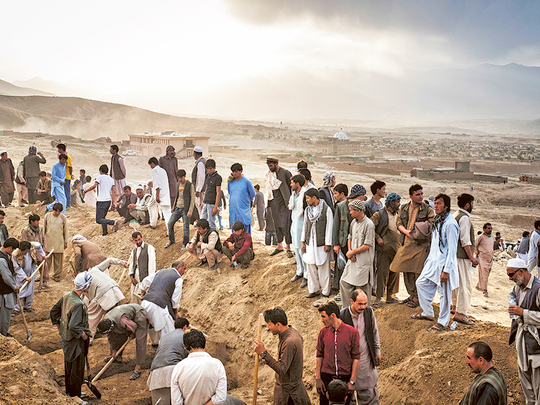
Kabul: Afghanistan’s security crisis is fuelling new opportunities for Al Qaida, the Daesh and other extremist groups, Afghan and US officials say, voicing concerns that the original US mission in the country — removing its use as a terrorist haven — is at risk.
As intense Taliban offensives have taken large portions of territory out of the Afghan government’s hands, those spaces have become the stage for a resurgence of regional and international militant groups. That is despite the extended presence of nearly 10,000 US troops in the country, tasked with performing counterterrorism operations and supporting the Afghan forces that are bearing the brunt of the fighting.
Gen. Joseph L. Votel, chief of the US Central Command, said the Afghan government now controls only about 60 per cent of the country, the Taliban hold sway over about 10 per cent, and the remainder is contested. Which group or groups fill those voids of increasingly ungoverned territory in Afghanistan “is something we’ll have to contend with,” he said.
“We have to be concerned about this — about the Taliban pulling together and cooperating and collaborating with other terrorist organisations,” Votel said at a security forum in Washington this week.
Overall, Western and Afghan officials estimate that 40,000 to 45,000 militants are active across Afghanistan. The Taliban are estimated at 30,000 fighters, some of them seasonal. But the rest are foreign militants of different — and often fluid — allegiances, at times competing but mostly on the same side against the Afghan government and its US allies.
“Of the 98 US- or UN-designated terrorist organisations around the globe, 20 of them are in the Af-Pak region,” Gen. John W. Nicholson, commander of US and Nato forces in Afghanistan, said recently. “This is the highest concentration of the numbers of different groups in any area in the world.”
It is that situation that President-elect Donald Trump and his new security team will inherit.
On the rare occasions that Trump has spoken of Afghanistan, it has usually been to state his desire to withdraw from what he has termed “a total and complete disaster.” But the most prominent member of the national security team he is assembling, Michael T. Flynn, a retired lieutenant general and former chief of the Defence Intelligence Agency who spent years focusing on the Afghan conflict, has been outspoken about his concerns that the chaos in Afghanistan may again directly threaten the United States.
“What we have to continue to do for that entire region is to reinstill confidence that we actually can help them,” Flynn said this year. “We cannot leave this region to the likes of these multiple terrorist organisations. There is too much at stake.”
How that debate will play out in the new administration has become a central question among Afghan officials in Kabul.
The immediate existential threat to the Afghan government has been a resurgent Taliban, who officials say have been killing 30 to 50 members of the security forces each day in recent months. The insurgents are directly threatening important provincial capitals and have again made important roadways hazardous or impassable to government forces.
The Taliban, whose leadership is mostly taking shelter in Pakistan, insist that they are focused only on regaining power within Afghanistan. And some Russian officials, including the special envoy to Afghanistan, Zamir Kabulov, have openly acknowledged maintaining some contact with the Taliban as a possible hedge against other militant groups if the government fails, though the officials insist that has not extended to aiding the insurgency.
Still, the insurgency’s recent success is directly threatening the Afghan government’s stability, and it is creating a territorial vacuum that other groups are trying to exploit.
An increasing focus of the US counterterrorism operation has been the local affiliate of the Daesh, which calls itself the Islamic State in the Khorasan, an ancient name for this region.
After heavy losses over the past year to US air strikes and Afghan ground operations, the Daesh cell is estimated at no more than 1,000 fighters, most of them former members of the Pakistani Taliban from the tribal areas, according to a senior US official, who spoke on the condition of anonymity to discuss intelligence.
Nevertheless, they have proved to be a resilient force that has maintained a hold on several districts in eastern Nangarhar province, and they continue to have contacts, for guidance and funding, with the Daesh’s central command in Syria and Iraq, officials say.
The Daesh militants have also taken a more active role in staging terrorist attacks. US intelligence agencies say that the group has carried out as many as seven mass-casualty attacks in Afghanistan since midsummer, including suicide bombings.
The Daesh affiliate in Kabul has largely been seen as a competitor with the Taliban, who have publicly criticised the group and battled it around its main stronghold in the east.
But two senior Afghan officials, speaking on the condition of anonymity to discuss new intelligence, said the idea that the Taliban had been fighting the Daesh was not an absolute fact, but rather varied across the country. While the Taliban have been waging a bloody turf war with Daesh in the east, they have been cooperating with elements associated with the Daesh in the north and northeast of the country, the officials said.
The senior US official also said the Haqqani militant network, whose top leader became deputy commander of the Taliban insurgency in 2015, had actually been “more open to discussions with the Islamic State [Daesh].”
Mohammad Haneef Atmar, Afghanistan’s national security adviser, warned that although the Daesh affiliates remain a top priority in the country’s joint counterterrorism efforts with the US military in Afghanistan, most of the terrorist groups in Afghanistan share similar ideologies.
“We cannot isolate Daesh from other terrorist groups,” Atmar said. “The groups all have symbiotic relationships. One group cannot stay in isolation; others provide the enabling environment.”
Second to the Daesh is Al Qaida, which has seen its capability largely decreased as its leaders have been targeted by US Special Operations and drone strikes. In addition to the core of the original group, which has remained focused on terrorist attacks abroad and has a presence in Afghanistan and Pakistan, Al Qaida has created a new branch based in those countries, Al Qaida in the Indian Subcontinent, or AQIS, that is more regionally focused, counterterrorism officials say.
US officials estimate that both the core Al Qaida group and the new branch number fewer than 200 total operatives in Afghanistan; Afghan officials put the number at 300 to 500.
“There is no change in the goals that Al Qaida is pursuing, which is the destruction of the West and Muslim democracies,” Atmar said. “The difference is that they are employing other networks, such as Haqqani and Lashkar-e-Taiba. They are outsourcing some of their work, and that makes them more dangerous.”












